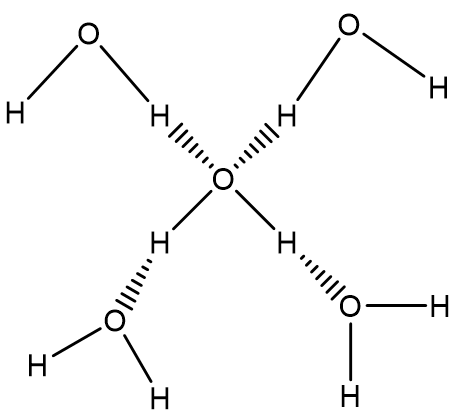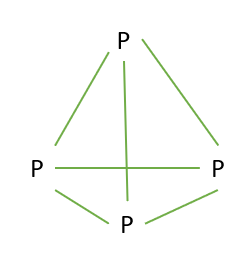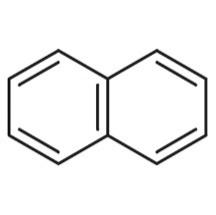
Which solid will have the weakest intermolecular forces?
(a) Ice
(b) Phosphorous
(c) Naphthalene,
(d) Sodium Fluoride
Answer
220.5k+ views
Hint: The London dispersion force, Van der waals interaction, and hydrogen bonding are the weakest intermolecular forces in comparison with covalent and ionic bonds.
Complete Step by Step Solution:
The London dispersion force, Van der waals, and Hydrogen bonding are the three major intermolecular forces.
The London dispersion and Van der waals forces are the weakest intermolecular forces than the hydrogen bonding.
The hydrogen bond is formed when nitrogen, oxygen, and fluorine are attached to a hydrogen atom. For example, \[N{H_3}\] and \[{H_2}O\] molecules possess hydrogen bonding.
In ice, every single water molecule is connected to four neighbouring water molecules via hydrogen bonding interaction (Image 1).

Image 1: Hydrogen bonding interaction in ice.
In the case of phosphorus, the four P atoms are bonded to each other by a covalent bond and form a tetrahedral geometry (Image 2).

Image 2: Covalent bonding in phosphorus (\[{P_4}\] ) molecules.
Similarly, naphthalene is a covalent molecule, in which the hydrogen and carbon atoms are bonded by means of a covalent bond (image 3). It is found that covalent bonds are stronger than that hydrogen bonding.

Image 3: Structure of naphthalene molecule.
Whereas, silver fluoride is an ionic compound, in which the silver and fluoride ions are fused together by means of strong ionic bond. It is found that ionic bonds are also stronger than hydrogen bonds.
the above statements, conclude that the hydrogen bond is a weaker intermolecular force than the covalent and ionic bonds.
Note: The hydrogen bonding interaction is also known as dipole-dipole interaction. The strength of hydrogen bonding depends upon the electronegativity of the element attached to the hydrogen atom.
Complete Step by Step Solution:
The London dispersion force, Van der waals, and Hydrogen bonding are the three major intermolecular forces.
The London dispersion and Van der waals forces are the weakest intermolecular forces than the hydrogen bonding.
The hydrogen bond is formed when nitrogen, oxygen, and fluorine are attached to a hydrogen atom. For example, \[N{H_3}\] and \[{H_2}O\] molecules possess hydrogen bonding.
In ice, every single water molecule is connected to four neighbouring water molecules via hydrogen bonding interaction (Image 1).

Image 1: Hydrogen bonding interaction in ice.
In the case of phosphorus, the four P atoms are bonded to each other by a covalent bond and form a tetrahedral geometry (Image 2).

Image 2: Covalent bonding in phosphorus (\[{P_4}\] ) molecules.
Similarly, naphthalene is a covalent molecule, in which the hydrogen and carbon atoms are bonded by means of a covalent bond (image 3). It is found that covalent bonds are stronger than that hydrogen bonding.

Image 3: Structure of naphthalene molecule.
Whereas, silver fluoride is an ionic compound, in which the silver and fluoride ions are fused together by means of strong ionic bond. It is found that ionic bonds are also stronger than hydrogen bonds.
the above statements, conclude that the hydrogen bond is a weaker intermolecular force than the covalent and ionic bonds.
Note: The hydrogen bonding interaction is also known as dipole-dipole interaction. The strength of hydrogen bonding depends upon the electronegativity of the element attached to the hydrogen atom.
Recently Updated Pages
Difference Between Alcohol and Phenol: Structure, Tests & Uses

Classification of Drugs in Chemistry: Types, Examples & Exam Guide

Class 12 Chemistry Mock Test Series for JEE Main – Free Online Practice

Is PPh3 a strong ligand class 12 chemistry JEE_Main

Full name of DDT is A 111trichloro22bispchlorophenyl class 12 chemistry JEE_Main

Sodium acetate on heating with soda lime produce A class 12 chemistry JEE_Main

Trending doubts
JEE Main 2026: Application Form Open, Exam Dates, Syllabus, Eligibility & Question Papers

Derivation of Equation of Trajectory Explained for Students

Hybridisation in Chemistry – Concept, Types & Applications

Understanding the Angle of Deviation in a Prism

How to Convert a Galvanometer into an Ammeter or Voltmeter

Degree of Dissociation: Meaning, Formula, Calculation & Uses

Other Pages
Solutions Class 12 Chemistry Chapter 1 CBSE Notes - 2025-26

NCERT Solutions For Class 12 Chemistry Chapter 1 Solutions - 2025-26

The D and F Block Elements Class 12 Chemistry Chapter 4 CBSE Notes - 2025-26

NCERT Solutions for Class 12 Chemistry Chapter Chapter 7 Alcohol Phenol and Ether

NCERT Solutions ForClass 12 Chemistry Chapter Chapter 8 Aldehydes Ketones And Carboxylic Acids

JEE Advanced Marks vs Ranks 2025: Understanding Category-wise Qualifying Marks and Previous Year Cut-offs




